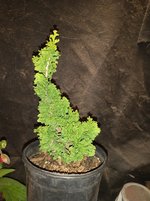Leo in N E Illinois
The Professor
- Messages
- 11,437
- Reaction score
- 23,653
- USDA Zone
- 5b
While in Saint Louis area, visiting my parents. Yes, even old farts such as myself sometimes are blessed (or cursed) with parents that are still alive. My folks are 90 years old each, mostly blind, and some dementia, but otherwise relatively healthy. They live in a care facility near Clarkston Rd and Clayton Rd, Ellisville MO. On Clarkston Road, between Manchester Road and Clayton Road is Timberbend Nursery. What a delightful nursery to visit. Nicely laid out, well staffed and full of interesting surprises for a jaded plant person such as myself.
At a reasonable price I found a one gallon (6 inch diameter, or 15 cm diameter) nursery pot of
Thuja occidentalis 'Primo'
The plant is roughly 25 cm (12 inches) tall from soil to top. Trunk is 12 mm in diameter, that is roughly half inch diameter, and appears to be cutting grown. That is one of the great things about Thuja and closely related Chamaecyparis (Hinoki), they can be propagated by rooting cuttings, which makes small bonsai possible. A quick feel in the dirt seems to indicate a fairly radial root system, just barely below the surface of the soil in the pot.
It appears to be a nice, densely budding dwarf or even miniature form of the normal form of Thuja occidentalis, sometimes called eastern white cedar, though it is not a true cedar and eastern refers to eastern North America. The Conifer Society website says it was a seedling selected in 2004 by Isle Nursery. It grows about 5 inches per year, which makes it a dwarf, not a "miniature".
I first saw the cultivar 'Primo' at a bonsai show in Royal Oaks, Michigan back in 2018 or 2019. I did a double take, as it really looks like a cultivar of Hinoki. But I was reassured by several there that indeed it is a cultivar of Thuja occidentalis. So when I saw 'Primo' at Timberbend Nursery, I knew I had to pick it up.
I don't know what I will do with it. Pot it is in is more than large enough for a year or two of additional growth. I did clean out some dead leaves. It grows very dense, and seems to shade out interior growth. I would assume it is no different than the normal form in terms of being unwilling to back bud on stems that have developed brown bark. For most forms of Thuja, once the stem matures from green to brown, back budding is no longer likely. It happens, but rarely and not predictably. For bonsai design purposes, it is best to assume there will be no back budding on stems old enough to have brown bark.
So this is my latest find. If anyone has experience with 'Primo' please share. I would love to know more about it.




At a reasonable price I found a one gallon (6 inch diameter, or 15 cm diameter) nursery pot of
Thuja occidentalis 'Primo'
The plant is roughly 25 cm (12 inches) tall from soil to top. Trunk is 12 mm in diameter, that is roughly half inch diameter, and appears to be cutting grown. That is one of the great things about Thuja and closely related Chamaecyparis (Hinoki), they can be propagated by rooting cuttings, which makes small bonsai possible. A quick feel in the dirt seems to indicate a fairly radial root system, just barely below the surface of the soil in the pot.
It appears to be a nice, densely budding dwarf or even miniature form of the normal form of Thuja occidentalis, sometimes called eastern white cedar, though it is not a true cedar and eastern refers to eastern North America. The Conifer Society website says it was a seedling selected in 2004 by Isle Nursery. It grows about 5 inches per year, which makes it a dwarf, not a "miniature".
I first saw the cultivar 'Primo' at a bonsai show in Royal Oaks, Michigan back in 2018 or 2019. I did a double take, as it really looks like a cultivar of Hinoki. But I was reassured by several there that indeed it is a cultivar of Thuja occidentalis. So when I saw 'Primo' at Timberbend Nursery, I knew I had to pick it up.
I don't know what I will do with it. Pot it is in is more than large enough for a year or two of additional growth. I did clean out some dead leaves. It grows very dense, and seems to shade out interior growth. I would assume it is no different than the normal form in terms of being unwilling to back bud on stems that have developed brown bark. For most forms of Thuja, once the stem matures from green to brown, back budding is no longer likely. It happens, but rarely and not predictably. For bonsai design purposes, it is best to assume there will be no back budding on stems old enough to have brown bark.
So this is my latest find. If anyone has experience with 'Primo' please share. I would love to know more about it.




